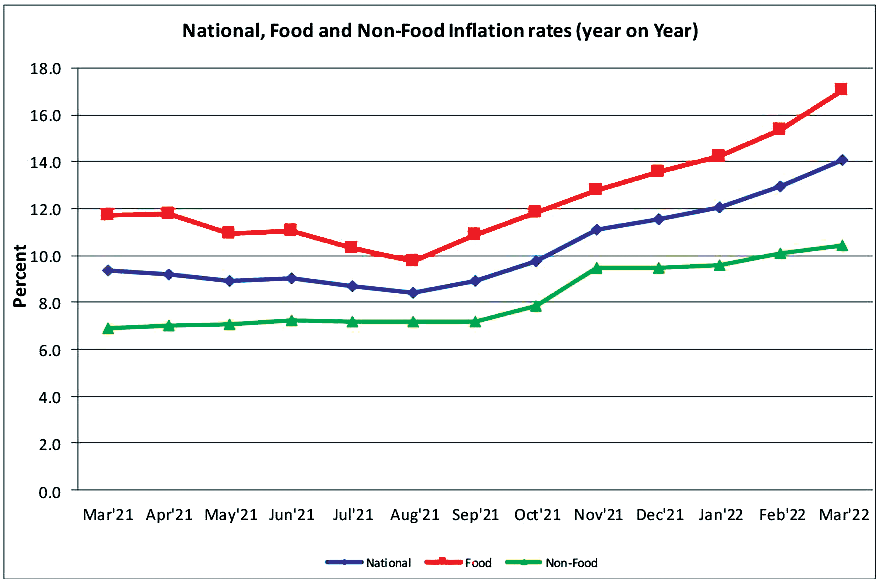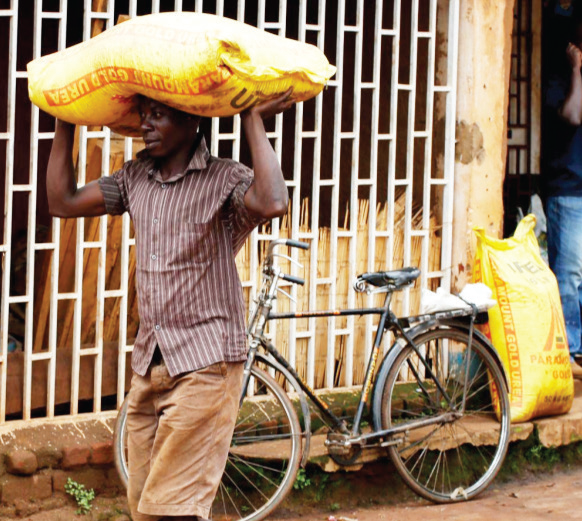Malawi’s year-on-year headline inflation at 14.1 percent in March on account of rising food prices and experts say this means continued rise in the cost of living and declining purchasing power.
Published National Statistical Office (NSO) figures on Friday showed that in comparison to the previous month, inflation, the rate of the increase in prices over a given period, rose by 1.1 percentage points from 13 percent recorded in February.
Food and non-food Inflation rates increased by 1.8 percentage points and 0.4 percentage points to 17.1 and 10.5 percent from 15.3 percent and 10.2 percent, respectively.
In an interview yesterday, Catholic University of Malawi economics lecturer Hopkins Kabaghe said consumers should expect the trend to continue following the increase in fuel prices.
“Most goods use road transport, as such, higher fuel prices will imply higher transportation cost, which is going to be reflected in prices of most commodities.
“The real income of consumers has declined and we know wages take time to adjust so they have to dig deep in their pocket to maintain the current welfare or expenditure. The poor suffer more.”
Economics Association of Malawi executive director Frank Chikuta said inflationary pressures are going to persist due to the recent hike in fuel prices and increasing prices of imported food items emanating from geopolitical tensions.
He, however, said the onset of the harvest season should result in subsiding inflationary pressures for the food component and, consequently, a decrease in headline inflation.
Speaking in a separate interview, Consumers Association of Malawi executive director John Kapito said the quick rise inflation confirms that the economy is in bad state, urging government to come up with economic policies which should include expenditure controls and reduction.
He said: “It is extremely hard in a country where the majority are experiencing economic [hardships] to see a certain group of Malawians living a life that is not equal to our revenue generation. Let us share the pain.”
In Malawi, maize, as part of the food component, accounts for about 45.2 percent of the consumer price index, an aggregate basket of goods and services used in computing inflation.
International Food Policy Research Institute data shows that during the review period, maize continued to sell at highest retail prices in the Southern Region, averaging 198 per kilogramme (kg), K180 per kg in the Centre and K157 per kg in the North.
Oil prices, on the other hand, have remained volatile due to potential supply constraints following the conflict in Ukraine.
Malawi Energy Regulatory Authority recently adjusted upwards pump prices of petrol, diesel and paraffin by 20 percent, 31.25 percent and 14.47 percent to K1380, K1470 and K956, per litre, respectively.
Meanwhile, the Reserve Bank of Malawi (RBM) has indicated that the ongoing war between Russia and Ukraine is a cause for concern, saying the higher-than-anticipated oil prices induced by the conflict could delay the convergence of inflation to medium-term targets in the country.
This, it said, could compel the central bank to implement less accommodative monetary policy that could jeopardise economic recovery plans.
The post Inflation rate up, consumers hit hard appeared first on The Nation Online.
 Moni Malawi
Moni Malawi 

